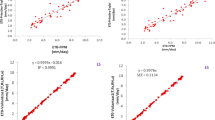Summary
Potential evaporation (E p) and actual evapotranspiration (E A) values for 84 East African stations were estimated and mapped using Morton [12, 13, 14] model. The data used in the study were long term averages up to and including 1974. TheE p andE A distributions for the months of January, April, and July and October; and annual are discussed. HighE p values exist in the semi-arid/arid areas of northern and northeastern Kenya and central Tanzania. LowE p values dominate on the highland areas. HighE A values are observed over the East African rainfall favoured and thickly vegetated areas whereas the lowestE A values are predominantly observed during all months in semi-arid/arid areas. BothE p andE p values show a good agreement with the north/south movement of the rain belts across East Africa.
Zusammenfassung
Es werden für 84 Stationen in Ost-Afrika nach der Methode von Morton [12, 13, 14] die Werte der potentiellen VerdunstungE p und der aktuellen EvapotranspirationE A bestimmt und ihre Verteilungen in Kartendarstellungen wiedergegeben. Als Beobachtungsdaten wurden langzeitige Mittelwerte bis einschließlich 1974 verwendet. Die Verteilung vonE p undE A wird für die Monate Januar, April, Juli, Oktober und für das Jahr besprochen. HoheE p -Werte kommen in den semiariden und ariden Gebieten von Nord- und Nordost-Kenya und von Zentral-Tanzania vor. NiedrigeE p-Werte sind in Hochlandgebieten vorherrschend. HoheE A -Werte werden in Ost-Afrika in den von Regen begünstigten und dicht mit Vegetation bewachsenen Gebieten beobachtet, während die niedrigstenE A-Werte vorwiegend in allen Monaten in semiariden und ariden Gebieten festgestellt werden. DieE p- undE A -Werte zeigen eine gute Übereinstimmung mit der Nord-Süd-Verlagerung der Regengürtel über Ost-Afrika.
Similar content being viewed by others
References
Chow, V. T.: Handbook of Applied Hydrology, 11.1-11. 3. New York: McGraw Hill 1964.
Chang, J. H.: Climate and Agriculture. An Ecological Survey, pp. 129–205. Chicago: Aladine 1971.
Rosenberg, N. J.: Microclimate. The Biological Environment. A Wiley-Interscience publication, pp. 159–205 (1974).
Ward, R. C.: Principles of Hydrology, pp. 83–124. New York: McGraw Hill 1975.
Gangopadhyaya, M., Uryvaer, V. A., Omar, M. H., Nordensen, T. J., Harbeck, G. E.: Measurement and Estimation of Evaporation and Evapotranspiration. WMO Tech. Note No. 83 (1966).
Kiangi, P. M. R.: A Review of Some Methods Used in Determining Actual Evapotranspiration in East Africa. Proc. of 13th Annual Symp. of E. A. Academy on the Role of Water Resources in Development. Ed. J. B. Castelino and C. P. M. Khamala, pp. 39–48 (1979).
Nyenzi, B. S.: Climatological Estimates of Actual and Potential Evapotranspiration Values in East Africa. M. Sc. thesis, Dept. of Meteorology, University of Nairobi, Kenya 1978.
Woodhead, T.: Studies of Potential Evaporation in Tanzania. Ministry of Lands, Settlement and Water Development. Government of Tanzania, 1968.
Woodhead, T.: Studies of Potential Evaporation in Kenya. Ministry of Natural Resources, Water Development Department. Republic of Kenya, 1968.
Brown, L. H., Cocheme, J.: A Study of the Agroclimatology of the Highlands of Eastern Africa. WMO Tech. Note No. 125, Geneva, pp. 67–85 (1973).
Obasi, G. O. P., Kiangi, P. M. R.: Water Balance in Kenya. The Kenya Geogr.1, 61–79 (1975).
Morton, F. I.: Catchment Evaporation and Potential Evaporation - Further Development of a Climatological Relationship. J. Hydrol.12, 88–99 (1971).
Morton, F. I.: Estimating Evaporation and Transpiration from Climatological Observation. J. Appl. Met.14, 488–497 (1975).
Morton, F. I.: Climatological Estimates of Evapotranspiration. J. Hydraulics Division, American Soc. Civil Engineers102, 275–291 (1976).
Penman, H. L.: Natural Evaporation from Open Water, Bare Soil and Grass. Proc. of Roy. Soc. (London)193, 120–145 (1948).
Sadler, J. C.: Mean Cloudiness and Gradient Level Wind Charts Over the Tropics. Air Weather Service, USAF, Vol. 11, Tech. Report No. 125, 1970.
Tomsett, J. E.: Average Monthly and Annual Rainfall Maps of East Africa, E. A. M. D., Tech. Mem. No. 14, 1969.
Blackie, J. R.: Hydrology and Afforestation in the Aberdares. E. Afr. Geogr. Rev.2, 17–22 (1964).
Obasi, G. O. P., Kiangi, P. M. R.: Monthly Distribution of Water Balance Components in Kenya, E. A. M. D., Tech. Note No. 24, 1973.
Edwards, K. A., Blackie, J. R., Cooper, S. M., Roberts, G., Waweru, E. S.: Summary of Hydrological Data from the E. A. A. F. R. O. Experimental Catchments. East African Community, 1976.
Pant, P. S., Rwandusya, E. M.: Climate of East Africa. E.A.M. D., Tech. Mem. No. 18, 1971.
Author information
Authors and Affiliations
Additional information
With 11 Figures
Rights and permissions
About this article
Cite this article
Nyenzi, B.S., Kiangi, P.M.R. & Rao, N.N.P. Evaporation values in East Africa. Arch. Met. Geoph. Biocl., Ser. B 29, 37–55 (1981). https://doi.org/10.1007/BF02278189
Received:
Issue Date:
DOI: https://doi.org/10.1007/BF02278189




